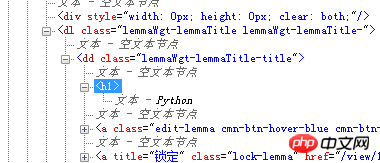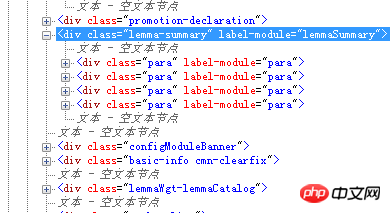
继续上一篇文章的内容,上一篇文章中已经将url管理器和下载器写好了。接下来就是url解析器,总的来说这个模块是几个模块中比较难的。因为通过下载器下载完页面之后,我们虽然得到了页面,但是这并不是我们想要的结果。而且由于页面的代码很多,我们很难去里面找到自己想要的数据。所幸,我们下载的是html页面,它是一种由多个多层次的节点组成的树型结构的文本文件。所以,相较于txt文件,我们更加容易定位到我们要找的数据块。现在我们要做的就是去原页面去分析一下,我们想要的数据到底在哪。
打开百度百科pyton词条的页面,然后按F12调出开发者工具。通过使用工具,我们就能定位到页面的内容:


这样我们就找到了我们想要的信息处在哪个标签里了。
1 import bs4 2 import re 3 from urllib.parse import urljoin 4 class HtmlParser(object): 5 """docstring for HtmlParser""" 6 def _get_new_urls(self, url, soup): 7 new_urls = set() 8 links = soup.find_all('a', href = re.compile(r'/item/.')) 9 for link in links:10 new_url = re.sub(r'(/item/)(.*)', r'\1%s' % link.getText(), link['href'])11 new_full_url = urljoin(url, new_url)12 new_urls.add(new_full_url)13 return new_urls14 15 def _get_new_data(self, url, soup):16 res_data = {}17 #url18 res_data['url'] = url19 #解析器只有一个外部方法就是parse方法,
a.首先它会接受url, html_cont两个参数,然后进行判断页面内容是否为空
b.调用bs4模块的方法来解析网页内容,'lxml'为文档解析器,默认的为html.parser,bs官方推荐我们用lxml,那就听它的吧,谁让人家是官方呢。
c.接下来就是调用两个内部函数来获取新的url列表和数据
d.最后将url列表和数据返回
这里有一些注意点
1.bs的方法调用还有一个参数,from_encoding 这个和我在下载器那里的重复了,所以我就取消了,两个的功能是一样的。
2.获取url列表的内部方法,需要用到正则表达式,这里我也是摸着石头过河,不是很会,中间也调试过许多次。
3.数据是放在字典中的,这样可以通过key来增改删除数据。
最好,就直接数据输出了,这个比较简单,直接上代码。
1 class HtmlOutputer(object): 2 """docstring for HtmlOutputer""" 3 def __init__(self): 4 self.datas = [] 5 def collect_data(self, new_data): 6 if new_data is None: 7 return 8 self.datas.append(new_data) 9 def output_html(self):10 fout = open('output1.html', 'w', encoding = 'utf-8')11 fout.write('')12 fout.write('
')13 fout.write('')14 fout.write('| %s | ' % data['url'])18 fout.write('%s | ' % data['title'])19 fout.write('%s | ' % data['summary'])20 fout.write('
这里也有两个注意点
1.fout = open('output1.html', 'w', encoding = 'utf-8'),这里的encoding参数一定要加,不然会报错,在windows平台,它默认是使用gbk编码来写文件的。
2.fout.write('
'),这里的meta标签也要加上,因为要告诉浏览器使用什么编码来渲染页面,这里我一开始没加弄了很久,我打开页面的内容,发现里面是中文的,结果浏览器展示的就是乱码。总的来说,因为整个页面采集过程结果好几个模块,所以编码问题要非常小心,不然少不留神就会出错。最后总结,这段程序还有许多方面可以深入探讨:
1.页面的数据量过小,我尝试了10000个页面的爬取。一旦数据量剧增之后,就会带来一下问题,第一是待爬取url和已爬取url就不能放在set集合中了,要么放到radi缓存服务器里,要么放到mysql数据库中
2.第二,数据也是同样的,字典也满足不了了,需要专门的数据库来存放
3.第三量上去之后,对爬取效率就有要求了,那么多线程就要加进来
4.第四,一旦布置好任务,单台服务器的压力会过大,而且一旦宕机,风险很大,所以分布式的高可用架构也要跟上来
5.一方面是页面的内容过于简单,都是静态页面,不涉及登录,也不涉及ajax动态获取
6.这只是数据采集,后续还有建模,分析…………
综上所述,路还远的很呢,加油!
The above is the detailed content of Problems related to crawler problem solving. For more information, please follow other related articles on the PHP Chinese website!




